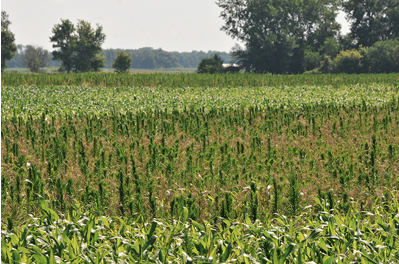Applying fall herbicides can be a tactic in fields with a history of problems with marestail, or where marestail seedlings are observed in fall.

Marestail competition/challenge in a cornfield. (Purdue University photo)
Research over the last couple of years has shown that two shot burndown programs which include either 2 shots in the spring or fall plus spring burndown treatments are needed in areas with a history of poor marestail control due to glyphosate and ALS herbicide resistance.
The primary goal of a fall treatment is control of emerged plants, and it is not a substitute for a preplant herbicide treatment the following spring. An application of burndown and residual herbicides is still required closer to the time of planting in fields that were treated in the fall. For fall applications, we suggest using 2,4-D (1 lb ae/A) as the base herbicide to control marestail, and combining it with one of the following to ensure control of other winter weeds:
1. Glyphosate; dicamba (or premix - Brash, WeedMaster, Outlaw, Rifle); Basis; Express; a low rate of Canopy/Cloak EX or DF; or metribuzin.
2. You can add Canopy/Cloak to other herbicide combinations to obtain residual control of weeds into spring. However, do not expect residual control from fall-applied Canopy/Cloak to adequately control spring-emerging marestail, especially in areas where ALS resistance is common. We generally do not recommend the use of other residual herbicides in the fall due to cost and lack of residual control into spring.
3. You can add Basis, or low rate of metribuzin or Canopy/Cloak to early-fall applications to control weeds that emerge later in fall, but this should not be needed from mid-October on since emergence during late October and early November is minimal due to cooler temperatures.





